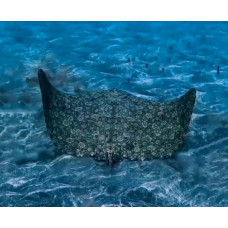Latin name
Gymnura altavela
Other name
Giant butterfly ray
Identification
The pectoral fins of the spiny ray are elongated in the form of broad "wings", the span of which far exceeds the length of the disc. They merge into a diamond-shaped disc. The snout is short and broad with a protruding tip. The front edge of the disc is curved. Behind the eyes there are large spiracles with tentacle-like projections along the edges. On the ventral side of the disc there is a rather large curved mouth, nostrils and 5 pairs of gill slits. The nostrils and mouth are close together. The mouth has 98-138 upper teeth and 78-110 lower teeth, occupying 70% of the jaw area. The teeth are small, narrow and pointed.
At the base of the caudal peduncle there are one or more spines on the dorsal surface. Immature rays have bare skin, while adults have areas covered with scales in the central part of the disk.
Features of fish fins
The pelvic fins are small and rounded. The tail is thin and short, its length not exceeding 1/4 of the disc length. Caudal, anal and dorsal fins are absent. There are dorsal and ventral ridges at the end of the caudal peduncle.
Fish colouring
The dorsal surface of the disc is dark brown, sometimes with light and dark patches forming a marbled pattern. In juveniles the tail is covered with alternating pale black and white stripes. The ventral side of the disc is white.
Distribution
Widespread in the Atlantic Ocean in subtropical and warm temperate waters. In the western Atlantic they are found from Massachusetts to the coast of Buenos Aires Province, Argentina. They are rare in the Gulf of Mexico, but more common in estuaries along the coast of Virginia. In the eastern Atlantic, they are found from Portuguese waters to Ambris, Angola, including the Mediterranean and Black Seas, Madeira and the Canary Islands.
Habitat
These demersal fish live in shallow brackish coastal waters on soft sandy or muddy bottoms at depths of 10 to 100 m, preferring sandy and muddy bottoms. They are generally few in number, but are more commonly caught in some of the most suitable habitats. Sex segregation is observed, with females usually remaining in deeper water and coming to shallow water to breed.
Size
The maximum recorded width of the spiny butterfly ray is 2.2m, other reports say 4m. The maximum recorded weight is 60kg.
Behavior
This species of fish uses its tail sting for defence.
Food and feeding habits
In the western Atlantic, they prey on bony fish, mainly ponyfish, small sharks and squid. Off the coast of Tunisia they feed on crustaceans, bony fish, cephalopods, mussels and gastropods. As stingrays grow, the proportion of bony fish in their diet increases. Active predators, they swim slowly towards their prey, then turn sharply and strike with the front edge of their pectoral fins. The powerful red muscles of the pectoral fins allow them to strike hard and stun the prey before catching it.
Reproduction
Spiny butterfly ray reproduce by oviparity. Embryos develop in the uterus and feed on egg yolk and histotrophs. Females have one functional ovary (left) and two uteri. Females give birth annually. Pregnancy lasts 4-9 months. The maximum number of litters depends on habitat: 4 in the Gulf of Mexico, 6 in the Mediterranean, 5 off Brazil and 8 in the north-west Atlantic. The length of the hatchlings is 38-44 centimetres. Their size is inversely proportional to the number of embryos in each uterus. They are a miniature replica of an adult stingray, without a spike. In the western Atlantic, males and females reach sexual maturity at 78 and 108 centimetres, and in the eastern Atlantic at 102 and 155 centimetres. Females mature later than males and generally reach larger sizes.
Fishing
The species is of interest to sport fishermen in some areas. Its meat is highly prized and it is fished commercially and artisanal throughout its range, except in US waters where it is not fished. In the southwest Atlantic they are caught by trawl, seine and hook-and-line fisheries.
Relationship with a person
Spiny butterfly rays are not normally dangerous to humans, but if accidentally stepped on, they can cause a painful sting with their tail spines.
| Classification | |
| Phylum | Chordata |
| Class | Chondrichthyes |
| Squad | Myliobatiformes |
| Family | Gymnuridae |
| Genus | Gymnura |
| Species | G. altavela |
| Features | |
| Conservation status | Endangered |
| Habitat | Bottom |
| Life span, years | No information |
| Maximum body weight, kg | 60 |
| Maximum length, cm | 400 |
| Sailing speed, m/s | No information |
| Threat to people | Edible |
| Way of eating | Predator |
Spiny butterfly ray
Tags: spiny butterfly ray

